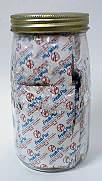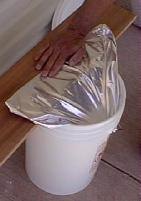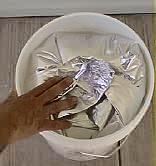Setting
Up:
First,
don't open the oxygen absorber bag until you are ready to preserve your food.
After you open the bag the oxygen absorbers immediately start to absorb oxygen
out of the air. So you have to work fast. If you are not planning on using
all the absorbers the day you open them up,  may
I suggest you have a small jam jar set aside. This jar shouldn't be any larger
than what you need to hold the excess absorbers. It takes a large mouthed quart
jar to hold 50 absorbers. Just like if you were canning produce, get a new
lid and boil it in water to soften the rubber seal. Open the oxygen absorber
bag and place the absorbers you don't plan on using during the day in it. Put
the newly boiled lid on top of the jar and tightly screw down the ring. The
absorbers will absorb the oxygen in the bottle then stop working. As this happens
the lid on the bottle will pop down, reflecting the partial vacuum that is
now inside the jar.
may
I suggest you have a small jam jar set aside. This jar shouldn't be any larger
than what you need to hold the excess absorbers. It takes a large mouthed quart
jar to hold 50 absorbers. Just like if you were canning produce, get a new
lid and boil it in water to soften the rubber seal. Open the oxygen absorber
bag and place the absorbers you don't plan on using during the day in it. Put
the newly boiled lid on top of the jar and tightly screw down the ring. The
absorbers will absorb the oxygen in the bottle then stop working. As this happens
the lid on the bottle will pop down, reflecting the partial vacuum that is
now inside the jar.
You
could also iron the oxygen absorber bag shut with the unused oxygen absorbers
inside. This is probably the better solution if you will be using all of them
the next time you open it up. For the oxygen absorbers you plan on using during
the next hour or two, have a zip log bag set aside to put them in. After they
are in the zip lock bag, push out all the air and zip it closed. This will
work for you temporarily, but is not a good solution for long term storage
of the oxygen absorbers. Use the bottle, or iron the original bag closed for
that. At this time you should also be ready to do your packing operation. Be
sure all the food you want to preserve, the cans or buckets, mylar bags, heated
clothes iron or Eurosealer and board are on hand.

Pull
the bag over the top of a 1 inch board and then...

Iron
it closed.

Now
pack the bag down inside the bucket and seal the lid.
|
The
operation:
Open
up the mylar bag and put it into the plastic bucket. Then pour the food you
are planning on preserving into the bag. Be careful you don't over fill the
bag. If you get it too full after the operation is complete you won't be able
to get the lid on the bucket. With the bag full of food, throw two or three
750cc oxygen absorbers in the bag on top of the food. (See the 'short
lesson on oxygen absorbers'
for
how many absorbers you need for a given application.)
Now,
lay a board across the top of the bucket so one edge of the board is half way
across the top of the opening of the bucket. Lay the bag over the top of the
bucket and using the clothes iron or Eurosealer, iron the bag shut. Now that
the bag is sealed closed, you can put the lid on the bucket and seal the lid
down. It's as easy as that, your finished with that bucket. If you are filling
lots of buckets at the same time, you might consider filling ten or more buckets
at once. Have all ten of the buckets at the stage where the oxygen absorbers
are to be thrown in. Then quickly add the absorbers to each bucket and quickly
iron the bag shut. This would save your oxygen absorbers from having to be
out in the air any longer than necessary. Before you started sealing your first
bucket, you'd pull 20 absorbers out, lay them side by side, and complete the
process on each of the ten buckets as quickly as possible. With a little practice,
you should be able to easily seal the ten bags in 5 minutes or less. With all
the bags ironed shut, install the ten lids on the buckets, and you are done.
If you are so lucky as to have access to a canning machine, the job is even
simpler. Just toss an oxygen absorber on top of the food before you seal the
lid on the can. It's as easy as that. If the oxygen absorbers are working they
will create a vacuum. After a few hours the lids on the cans will pop down
or the mylar bags will pull in around the food in the buckets.

